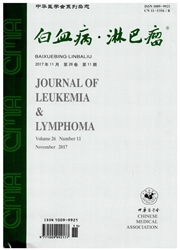

 中文摘要:
中文摘要:
目的本研究旨在探讨微小残留病监测在t(8;21)急性髓系白血病(AML)中的预后意义。方法回顾性分析于2013年1月至2016年1月就诊于郑州大学人民医院的42例t(8;21)AML患者,应用实时定量PCR(RQ-PCR)技术,连续监测患者的AML1-ETO融合基因表达水平,以此代表微小残留病(MRD),分析其动态变化与复发和预后的关系。结果患者的年龄、性别、白细胞计数、血红蛋白量、血小板水平等临床特征与初诊时的AML1-ETO融合基因表达水平无关。1个疗程巩固治疗后,AML1-ETO融合基因表达水平比诊断时下降小于3个对数级者,与下降大于3个对数级者相比,3年的无病生存率(DFS)分别为:(46.3±9.2)%和(73.4±8.7)%(P=0.017),3年的总生存率(OS)分别为:(49.2±10.7)%和(75.9±9.8)%(P=0.013)。治疗结束随访期间,AML1-ETO融合基因表达水平持续低于0.001%者均未复发。结论 RQ-PCR技术连续动态监测t(8;21)AML的MRD水平,具有重要的预后价值。
 英文摘要:
英文摘要:
Objective This study aims to investigate the role of minimal residual disease monitoring in t( 8; 21) acute myeloid leukemia( AML). Methods The clinical features and experimental results of 42 t( 8; 21) AML patients newly diagonsed in our department from Jan. 2013 to Jan 2016 were analysed retrospectively. The relationgship between the minimal residual disease( MRD) and prognosis were analysed by continuous monitoring of AML1- ETO fusion gene expression level using real- time quantitative PCR( RQ- PCR) technology. Results Clinical features including age,sex,white blood cell count,hemoglobin,platelet level were not related to the level of AML1- ETO fusion gene expression in newly diagnosed patients. After one course of consolidation therapy,patients with a less than 3 log reduction of AML1- ETO fusion gene expression level with respect to the level at diagnosis,compared to patients with a more than 3log reduction,3 years disease- free survival( DFS) and overall survival( OS) were:( 46. 3% ± 9. 2%) vs( 73. 4% ±8. 7%)( P = 0. 017) and( 49. 2% ± 10. 7%) vs( 75. 9% ± 9. 8%)( P = 0. 013) respectively. In the follow- up period,patients with AML1- ETO fusion gene expression level consistently below 0. 001% did not relapse. Conclusion Continuous dynamic MRD monitoring by RQ- PCR technique has important prognostic value in t( 8; 21) AML papients.
 同期刊论文项目
同期刊论文项目
 同项目期刊论文
同项目期刊论文
 期刊信息
期刊信息
